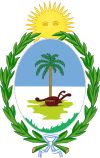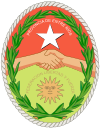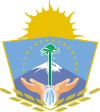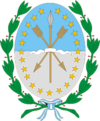Coat of arms of Argentina
| Coat of arms of Argentina[1] | |
|---|---|
 | |
| Versions | |
 Alternative | |
| Armiger | Argentina. |
| Adopted | 1813, 1944. |
| Crest | A Sun of May or. |
| Shield | An oval party per fess bleu celeste and argent; the two shaking hands in base come together to hold a pike with a Phrygian cap gules in chief. |
| Other elements | The whole surrounded by a wreath of laurel vert and tied with a banner. |
| Earlier version(s) | The seal of a French group in the National Assembly (around 1793) and the seal of the General Constituent Assembly (1813). |
The coat of arms of Argentina (Template:Lang-es) was established in its current form in 1944, but has its origins in the seal of the General Constituent Assembly of 1813.[2] It is supposed that it was chosen quickly because of the existence of a decree signed on February 22 sealed with the symbol.[3] The first mention of it in a public document dates to March 12 of that same year, in which it is stated that the seal had to be used by the executive power, that is, the second triumvirate. On April 13 the National Assembly coined the new silver and gold coins, each with the seal of the assembly on the reverse, and on April 27 the coat of arms became a national emblem. Although the coat of arms is not currently shown on flags, the Buenos Aires-born military leader Manuel Belgrano ordered to paint it over the flag he gave to the city of San Salvador de Jujuy, and during the Argentine War of Independence most flags had the coat of arms.
Description
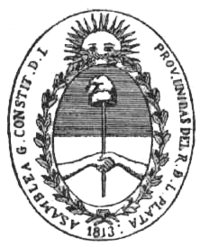

It is unknown who designed the coat of arms. It is often mentioned that there were three men involved: Alvear, Monteagudo, and Vieytes, but it is known that a few years before, President Bernardino Rivadavia asked the Peruvian Antonio Isidoro Castro to create an Argentine coat of arms; however, the two schemes have never been found.
The coat of arms is a figure, in which at the top we find the gold-yellowed Sun of May, also found on the flag of Argentina. The rising sun symbolizes the rising of Argentina, as described in the first version of the Argentine National Anthem, se levanta a la faz de la tierra una nueva y gloriosa nación, meaning "a new and glorious nation rises to the surface of the Earth". It must be noticed how the verb "rise", and so in Spanish, can be used to describe the motion of the Sun.
In the center ellipse there are two shaking hands, connoting the unity of the provinces of Argentina. The hands come together to hold a pike, which represents power and willingness to defend freedom, epitomized by the Phrygian cap on the top of the spear.
The blue and white colors are symbols of the Argentine people and the same colors of the Argentine flag. The blue half of the ellipse symbolizes the sky and the white one denotes the Río de la Plata.
The hands are flesh coloured and stand for friendship, peace, unity, and brotherhood. The pike is brown (wooden), and the Phrygian cap is red, like the traditional French liberty cap. The proximity of the hands and the Phrygian cap, in addition to their individual meanings, represent the national motto of Argentina, en unión y libertad ("in unity and freedom"), and illustrate the idea that in unity (the hands) there is power (the pike), and in power there is freedom (the Phrygian cap).
The Phrygian cap was typically worn by the inhabitants of Phrygia, in the Anatolian peninsula, but in ancient Rome it became a symbol of freed slaves, who were touched by their owners with a wooden pike before setting them free.
Laurel is another classical symbol. At the end of the ancient Olympic Games, the winner was given a laurel crown, and since then it has symbolized triumph and glory.
Provincial shields
References
- ^ "National country symbols of Argentina". National-symbol.com. Retrieved November 27, 2011.
- ^ "Que el Escudo, la Bandera, el Himno y su letra son los símbolos de la soberanía de la Nación" (in Spanish). Ministry of Economy and Production. Retrieved November 27, 2011.
En adelante se adoptará como representación del escudo argentino, la reproducción fiel del Sello que usó la Soberana Asamblea General Constituyente de la Provincias Unidas del Río de la Plata, el mismo que ésta ordenó en sesión de 12 de marzo de 1813, usase el Poder Ejecutivo.
{{cite web}}: Unknown parameter|trans_title=ignored (|trans-title=suggested) (help) - ^ "Símbolos Nacionales" (in Spanish). Presidency of the Argentine Nation. Retrieved November 27, 2011.
Como testimonio de ello, se conservan dos cartas de ciudadanía expedidas por la Asamblea el 22 de Febrero de 1813, donde figura el Escudo estampado en lacre: una de ellas se conserva en el Museo Histórico Nacional, extendida a favor de Don Antonio Olavaria, y está firmada por el presidente del cuerpo, general Carlos María de Alvear, y el secretario, Don Hipólito Vieytes.
{{cite web}}: Unknown parameter|trans_title=ignored (|trans-title=suggested) (help)
Further reading
- Símbolos Nacionales de la República Argentina (in Spanish). Buenos Aires: Comisión Administradora de la Biblioteca del Congreso de la Nación. 1997. ISBN 950-691-036-7.






